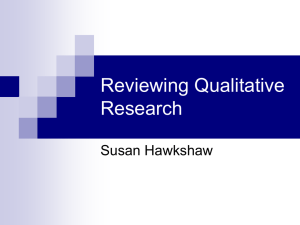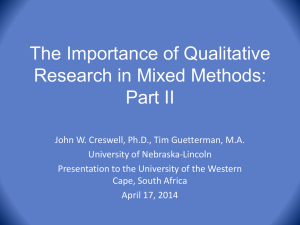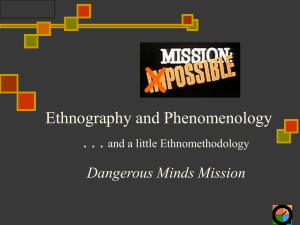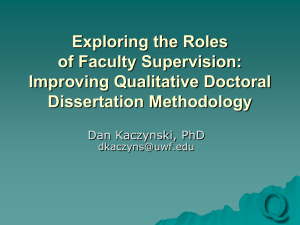QUALITATIVE RESEARCH DESIGNS
advertisement
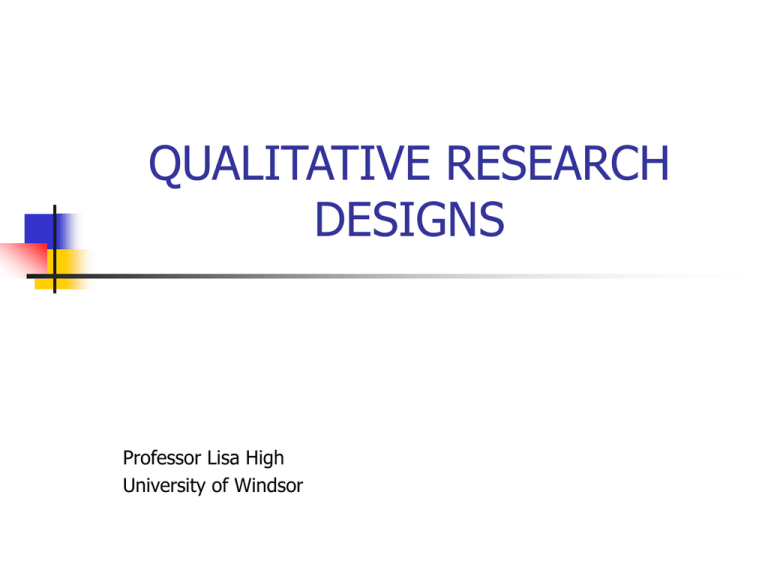
QUALITATIVE RESEARCH DESIGNS Professor Lisa High University of Windsor QUALITATIVE PARADIGM Naturalistic paradigm Soft science Focus: usually broad Holistic Subjective Reasoning: dialectic, inductive Basis of knowing: meaning, discovery Shared interpretation Communication and observation Basic element of analysis: words Individual interpretations Uniqueness The “Logic” of Qualitative Research (1) (2) Based on holistic view & following beliefs: There is no single reality – reality is based on perceptions – it is different for each person – changes over time What we know has meaning only within a given situation or context The reasoning process in qualitative research involves: - perceptually putting pieces together to make wholes What is the concept of “Gestalt”? - This concept is closely related to “wholism” and proposes that a particular phenomenon is organized into a cluster of linked ideas, “a gestalt”. Disadvantage: understand a phenomenon through the interpretation of a particular theory Experiencing “Gestalt Change” First to deconstruct your original sedimented views Reconstruct another view Focus on a different view point or looking at something differently (a different lens) To increase openness Philosophy and Qualitative Research (a) (b) (c) Frameworks are not used the same as in quantitative The goal is not theory testing Each study should be guided by a particular philosophical stance Philosophical Stance assists to: directs the question(s) that are asked the observations which are made the interpretation of data DESIGN OF QUALITATIVE STUDIES (a) (b) (c) (d) Specify design before data collection Adhere to the design after study started Study design evolves over time Researcher Decisions include: How to obtain From whom to collect How to schedule How long Design of Qualitative Research EMERGENT DESIGN A design that emerges as the researcher makes ongoing decisions reflecting what has already been learned Lincoln & Cuba (1985) – not researcher laziness or sloppiness – but rather desire to base inquiry on realities and viewpoints of those under study Key: realities and viewpoints that are NOT KNOWN or UNDERSTOOD AT THE OUTSET Characteristics of Qualitative Research Design Flexible, elastic, capable of adjusting Merging together of various data collection strategies Holistic, understand the whole Research intensely involved Research to become the research instrument Requires ongoing analysis of data to formulate subsequent strategies and to determine when field work is done What is “Bricolage?” Qualitative Designs (1) (2) (3) PHASES of a Qualitative Study: Orientation an overview Focused exploration Confirmation and closure (Lincoln & Cuba, 1985) Qualitative Design Features Control over the independent variable Type of group comparisons Number of data collection points Occurrence of the independent & dependent variables Qualitative Research Traditions (1) (2) (3) (4) Four traditions described by nurse researcher: Ethnography Phenomenology Grounded Theory Historical Research ETHNOGRAPHY Research tradition in anthropology Provides a framework for studying meanings, patterns, and experiences defined by a cultural group in a holistic fashion Ethnoscience (Cognitive Anthropology): focuses on the cognitive world of a culture – semantic rules and shared meanings that shape behavoir ETHNOGRAPHY Focus: the culture of a group of people Assumption: every human group evolves a culture that guides members view of the world and the way they structure their experiences At times referred to as “macroethnography: - able to study broadly defined cultures At times referred to as “microethnography” – able to study cultures using a very narrow focus Ethnography Cont’d (1) (2) Aim: to learn from rather than study members of a cultural group Two perspectives: Emic – insider’s view, the way the members of a culture envision their world Etic - outsiders’ interpretation of the experiences of that culture – strive to get at cultural experiences that members do not talk about or may not even be consciously aware Ethnography Cont’d Extensive field work Typically labor intensive Time consuming Researcher as instrument - to study a culture it requires a certain level of intimacy – needs to be developed – become one within the culture Ethnography Cont’d (1) (2) (3) Three types of information: Cultural behavoir Cultural artifacts Cultural speech Sources of information – in-depth interviews, records, charts, observations and other types of physical evidence are used Ethnography Cont’d - - Products of this research includes: rich and holistic descriptions describe normative behavoir and social patterns Information about health beliefs and health practices Facilitates an understanding of behavoirs affecting health and illness Leininger coined the phrase: “ethnonursing research” –the study and analysis of local or indigneous people’s viewpoints, beliefs and practices about nursing care behavoir and processes of designated cultures Phenomenology Phenomenology is both philosophy and a research method Purpose of this research method is to describe experiences as they are lived – to capture the “lived experience” Developed by Husserl & Heidegger – an approach to thinking about people’s life experiences. Phenomenology Cont’d Philosophical Orientation view the person as integral with the environment World is shaped by the self and also shapes the self The person is a self within a body Person is referred to as “embodied” – our bodies provide the possibility for the concrete actions of self in the world The body, the world and the concerns, unique to each person, are the “context” within which that person can be understood “being in time” Phenomenology Cont’d A phenomenological researcher asks the question: “What is the essence of this phenomena as experienced by these people and what does it mean?” Assumption: there is an “essence” an essential variant structure Investigates subjective phenomena Belief that truths about reality are grounded in peoples’ lived experiences Phenomenology Cont’d Two Schools of Thought: (1) Descriptive phenomenology (1) Interpretive phenomenology (hermeneutics) Phenomenology Cont’d Four aspects of the lived experience: (1) SPATIALITY (2) CORPOREALITY (3) TEMPORALITY (4) RELATIONALITY Phenomenology Cont’d Phenomenologists believe – human existence is “meaningful” and “interesting” “Being in the world” or “Embodiment” is a concept that acknowledges people’s physical ties to their world People: THINK SEE HEAR FEEL CONCIOUS OF THEIR BODIES INTERACTION WITH THE WORLD Phenomenology Cont’d Data sources: In-depth conversations Researcher helps the participant to describe lived experiences without leading the discussion Two or more interviews/conversations are needed Usually small number of participants (ie. 10 or less) May use participation, observation and introspective reflection Phenomenology Cont’d Methodological Interpretations Used: (a) BRACKETING (b) INTUITING Grounded Theory Is an inductive research technique developed for health-related topics by Glaser & Strauss (1967) Emerged from the discipline of sociology “Grounded” – means the theory developed from the research is grounded or has it roots in the data from which is was derived Grounded Theory Cont’d Philosophical Orientation: Based on symbolic interaction theory Explores how people define reality and how their beliefs are related to their actions Meaning is expressed through – symbols – such as words, religious objects, and clothing Symbolic meanings are different for each of us In social life - meanings are shared by groups – socialization process Group life is based on consensus and shared meanings Grounded Theory Cont’d Is an approach to study the social processes and social structures Focus: is the evolution of a social experience – the social and psychological stages that characterize a particular event of process Grounded Theory Cont’d - Methodology: does not begin with a focused research question the question emerges from the data - fundamental structure feature – - is the “data collection” is the “data analysis” Is the sampling of participants occurs simultaneously This procedure is referred to as “constant comparison” Grounded Theory Cont’d Constant Comparison: is used to develop and refine theoretically relevant categories and to identify the basic problem Categories that are elicited from the data are constantly compared with data obtained earlier so that “commonalities” and “variations” can be determined Categories can be “condensed” and “collapsed” Grounded Theory Cont’d Data Sources: - in-depth interviews are most common Observational methods Existing documents - Usually a sample of 25 to 50 informants - - Has contributed to the development of middle range nursing theories Historical Research Historiography examines events of the past Historians believe the greatest value of historical knowledge is an increased self-understanding Philosophical Orientation: A very old science Primary question “Where have we come from, who are we, and where are we going?” Myths, past, present and future are not distinguishable Myths are a form of story telling Historical Research Cont’d History moves beyond the myth Chronicling events, deeds, victories and stories about people and civilizations Comparing histories, identifying patterns Aim: to discovery new knowledge Seeking to answer questions concerning causes, effects and trends relating to past events To shed light on present behaviors and practices Historical Research Cont’d Assumptions: (a) There is nothing new under the sun (a) One can learn from the past Sampling in Qualitative Research Usually small, non-random samples Concern: measure attributes and relationships in a pop’n Need a representative sample Aim: to discover meaning, uncover multiple realities, therefore generalization is not a guiding criteria Sampling in Qualitative Research (1) (2) (3) (4) (5) Types of sampling: Convenience sampling Snowball sampling Theoretical sampling Purposeful sampling – several strategies – maximum variation sampling, extreme/deviant case sampling, and typical case sampling Simple random Sample Size (a) (b) (c) No firm establishment of criteria or rules Should be determined on the basis of informational needs Is largely a function of: the purpose of the inquiry the quality of the informants The type of sampling strategy used Sample Size Guiding Principle is that of, DATA SATURATION: sampling to the point at which no new information is obtained and redundancy is achieved Critiquing the Sampling Plan (a) (b) Evaluate the sample plan based on the following: Terms of its adequacy Terms of its appropriateness Adequacy means – Appropriateness means - Assessment of Qualitative Data (1) (2) (3) (4) Need to address validity and reliability Do the measures used by the researcher yield data reflecting the truth? Lincolon & Cuba (1985) – four criteria: Credibility Dependability Confirmability Transferability (criteria for establishing “trustworthiness”) Assessment of Qualitative Data Credibility – refers to confidence in the truth of the data Prolonged engagement Persistent observation Triangulation External checks – peer debriefing & member checks Researcher credibility Assessment of Qualitative Data (a) (b) Dependability – refers to data stability over time and over conditions Steps to approach: Stepwise replication Inquiry audit Assessment of Qualitative Data Confirmability –refers to the objectivity or neutrality of the data – what does that mean? AUDIT TRAIL: Transferability – refers to the extent to which the findings from the data can be transferred to other settings or groups = similar to the concept of generalizability THICK DESCRIPTION:
